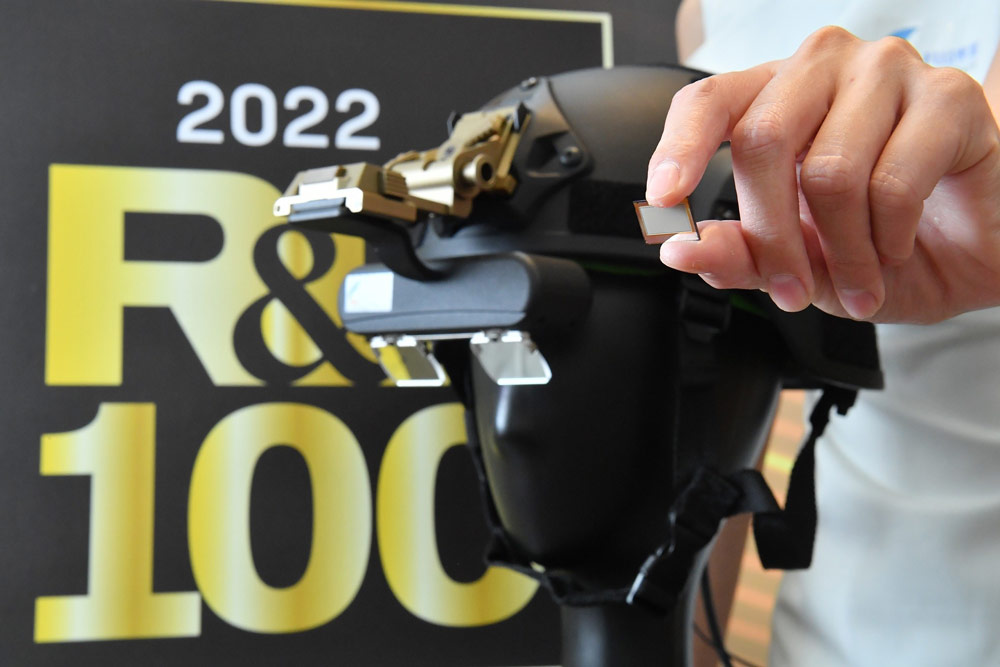News: LEDs
22 November 2022
ITRI introduces high-resolution full-color micro-LED display for AR glasses
Taiwan’s Industrial Technology Research Institute (ITRI) has introduced the High Resolution Full-Color Micro-LED Display for AR Glasses, which aims to assist panel makers and other industry players to upgrade their technology, expand their micro-LED applications, meet market demand and secure business opportunities in next-generation augmented reality (AR) display products for immersive experiences in the metaverse.
The High Resolution Full-Color Micro LED Display for AR Glasses has four key features:
- High resolution (>2000PPI), suitable for AR applications.
- High brightness (>20,000nits), 10 times higher than the smart glasses currently on the market and hence usable in outdoor scenarios, meeting the brightness requirements of the existing plug-in side-projection AR light machines and potentially surpassing the performance of counterpart displays such as OLED-based designs.
- Compatibility (< 0.5-inch), the display and sensor functions are integrated in a compact design, giving a slim look.
- Low power consumption (<1W), by consuming less than half the energy of conventional smart glasses, the device can be worn for long hours without recharging.
The design adopts heterogeneous integration technology similar to semiconductor processes to create micro-displays with wide color gamut by bringing micro-LED, CMOS and quantum-dot color conversion layers together within a single panel.

Picture: ITRI's micro-LED display.
Global availability for technology transfer
The High Resolution Full-Color Micro LED Display for AR Glasses is sold as system-oriented industry integration and fabrication platform services, and is available globally for transfer.
“ITRI’s High Resolution Full-Color Micro LED Display for AR Glasses has high commercial value and can enhance user experience due to its high resolution, high brightness, device compatibility, compact size and low power consumption,” says Dr Shih-Chieh Chang, general director of ITRI’s Electronic and Optoelectronic System Research Laboratories. “This high-resolution micro-LED will help leading global display players to capitalize on the vast range of emerging micro-LED applications,” he adds. “ITRI has assisted manufacturers in pilot production and technology transfers, which have laid the foundation for developing in-vehicle displays and next-gen XR glasses.”
Micro-LED Alliance
To introduce its micro-LED technology into augmented reality applications and deliver it from lab to market, ITRI founded an alliance in 2016 to integrate the industry chain horizontally. The alliance connects about 50 industry chain suppliers in advanced materials, semiconductor processes, and precision equipment. It provides comprehensive upstream to downstream solutions to fulfill industry needs for the various stages of verification, development, and IP licensing.
Micro-LED applications
Micro-LEDs are attracting attention for wearable electronics, lighting and biomedicine because of their high efficiency, small form factor, and low power consumption. Wearable micro-LED displays have thin, lightweight and unbreakable features, enabling the application of displays on curvilinear surfaces. Good color purity and high brightness with low power consumption, high-resolution quantum-dot (QD) array patterning, and ultrathin and ultrasmall form factors make QD-based micro-LEDs promising for flexible and wearable electronics. Micro-LEDs are suitable for advanced display applications such as smartphones, wearable watches, micro-projectors, AR/MR displays, automotive heads-up displays, ultra-high-definition (UHD) (>4K resolution) televisions, and large-scale monitors including outdoor TVs, sports and advertisement signage.
Micro-LED manufacturing process
The manufacturing process for the High Resolution Full-Color Micro-LED Display for AR Glasses requires semiconductor-grade device processing, micron-grade accuracy of assembly and a highly accurate yet rapid testing methodology. These steps usually require an upgrade or improvement in equipment, operation, logistics, materials and training.
The micro-LED display manufacturing process differs from the traditional LED manufacturing process in requiring a high-efficiency micron-grade LED process and heterogeneous bonding technology with high precision and high resolution on an active backplane. The overall process requires additional semiconductor processes such as high-precision photolithography, chemical-mechanical planarization (CMP), plating and high-precision alignment wafer bonding. Compared with the Class 1000 cleanroom processing used by traditional LEDs, a micro-LED lab needs a Class 10 cleanroom to heterogeneously integrate all components without concerns for particle contamination.
EVG expands collaboration with ITRI on heterogeneous integration process development









